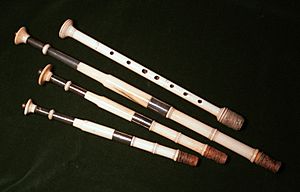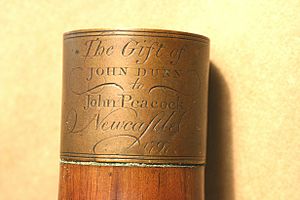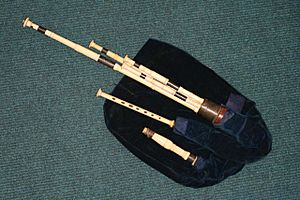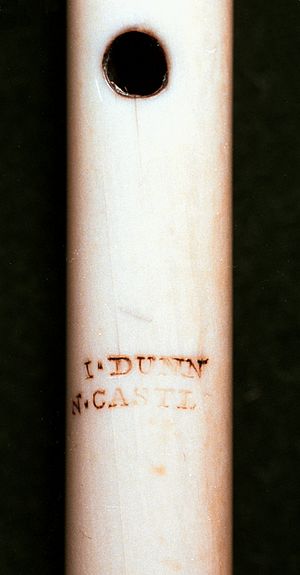John Dunn (pipemaker) facts for kids
John Dunn (around 1764–1820) was a famous maker of bagpipes. He was born in Newcastle upon Tyne, England. John Dunn worked as a cabinet maker, which means he built fine wooden furniture. He also worked as a "turner," someone who shapes wood using a special machine called a lathe.
John Dunn lived at Bell's Court in Newcastle. He passed away in 1820 and was buried in St. John's, Newcastle. Some people think his father was also named John Dunn, from Longhorsley, and that he was born on September 3, 1764. It's important not to mix him up with another pipemaker, M. Dunn, who made a different type of bagpipes called Union pipes.
Contents
John Dunn: Bagpipe Innovator
John Dunn was especially known for making Northumbrian smallpipes. These are a type of bagpipe from the Northumberland area of England. He is thought to be the first person to add keys to the chanter of these pipes around the year 1800. The chanter is the part of the bagpipe that plays the tune.
Adding keys was a big deal! Before Dunn, the chanter could only play notes within one octave (like playing from C to C on a piano). By adding keys, Dunn made it possible to play more notes, extending the range of the instrument. This change helped create the modern Northumbrian smallpipes we know today.
How Keys Changed the Pipes
The earliest proof of these new keyed chanters comes from a music book by John Peacock. This book, published around 1800, showed two types of chanters. One was a simple chanter without keys. The other was called "J. Peacock's New Invented Pipe Chanter with the addition of Four Keys." These keys allowed players to hit extra notes.
Later pipemakers, like Robert Reid, added even more keys. This made the pipes able to play an even wider range of notes, including "chromatic notes" (the sharps and flats on a piano).
Special Pipes for John Peacock
In 1797, John Dunn gave a set of pipes to John Peacock. These pipes had a special metal ring on the drone-stock (part of the pipes that holds the drone pipes). This ring was engraved with the words: 'The Gift of John Dunn to John Peacock Newcastle 1797'. It's believed that the famous engraver Thomas Bewick did this beautiful engraving.
Today, this special set of pipes is kept at the Morpeth Chantry Bagpipe Museum. It was bought by the Society of Antiquaries of Newcastle upon Tyne with help from the Victoria and Albert Museum in 2004.
Other Surviving Instruments
Several other sets of pipes made by John Dunn still exist today. One of these sets was made for Robert Bewick (Thomas Bewick's brother). This set is also now at the Morpeth Chantry Bagpipe Museum.
After John Dunn passed away in 1820, his son, who was also named John, took over the family business. Records show that in 1822, the son was paid for some work on pipes. John Dunn's son continued to be listed as a cabinet maker in business directories until 1855.





